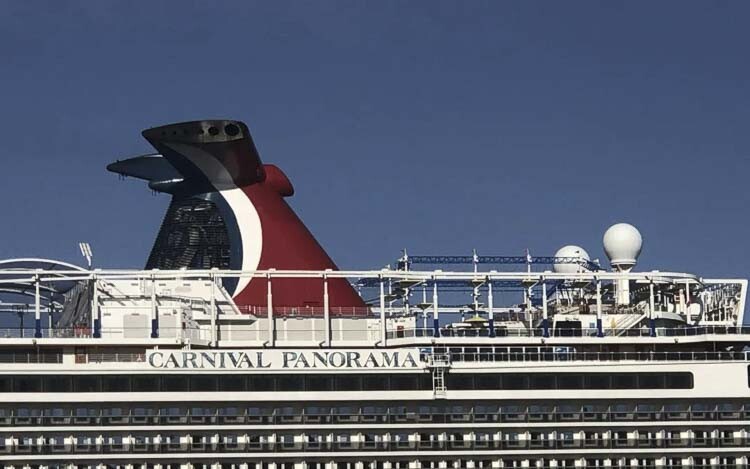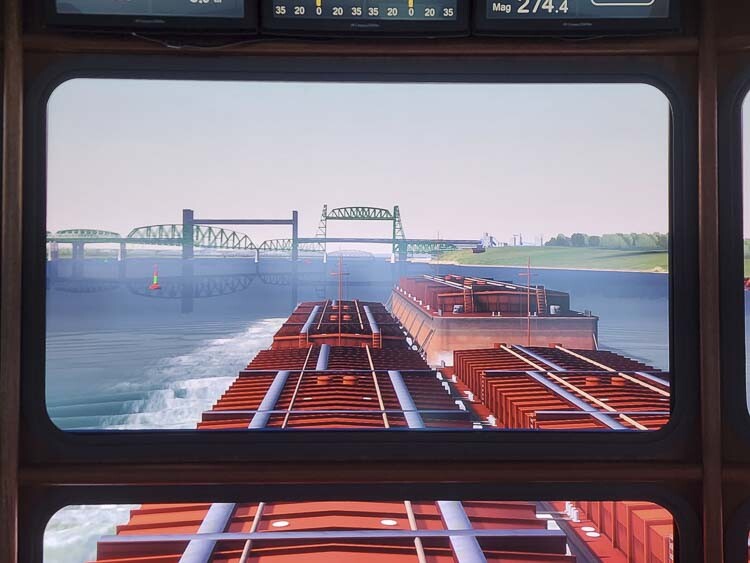
Narrow horizontal clearance during construction adds safety concerns for tug boat Captains
John Ley
for Clark County Today
What does a Carnival Cruise Line ship and the Interstate Bridge Replacement (IBR) have in common? They came together in a social media posting about a cruise ship being “too tall” to fit under Columbia River bridges to get to a Swan Island dry dock.
The Carnival Panorama had mechanical problems with its propulsion and steering systems and needed to get to a Portland dry dock that had an opening. It came from southern California to effect repairs. Hayden Island resident Sam Churchill posted a report showing the “whale tail” exhaust cover is too tall to fit under both the Astoria and Longview bridges to get to Portland.
The US Coast Guard is required to protect maritime navigation for the country’s navigable waters. They are currently engaged in a battle with the Interstate Bridge Replacement Program (IBR) team members who want a replacement bridge for I-5 to provide only 116 feet of clearance for marine traffic. The Coast Guard is demanding the current 178 feet of clearance, and would prefer unlimited clearance that could be provided with either a bascule bridge or a tunnel.

According to The Ship Report, the exhaust cover of the Panorama was 10 to 11 feet too tall to fit under the two bridges. The Panorama went to Vancouver, BC and had the whale tail removed, and returned a few days later to sail down the Columbia River. The ship is only 4 years old, serving as the largest of Carnival’s Vista class ships.
The timing was critical, as the Panorama was going to enter the Columbia at an expected 6 foot high tide. As it traveled down the river, water levels would drop allowing it to fit under the Longview bridge which provides 195 feet of clearance for marine traffic.
In response to the social media posting, a tug boat crew member posted two pictures from recent simulator sessions he and other mariners had where they practiced navigating a new Interstate Bridge replacement. An opinion was expressed that the IBR must be leaning towards the movable span option for the IBR, since the simulation showed that with 178 feet of clearance for marine traffic.
There was a second graphic of them navigating both bridges, simulating river navigation during construction of the new bridge, while the old bridges remained standing. Clearly, safely navigating the river while both bridges are in the water during construction will be the greatest challenge.
Clark County Today spoke with one boat captain who chose to remain anonymous. The biggest challenge will be safely navigating both the current two bridge structures and the replacement IBR bridge structures in fast moving river currents. The crews were required to deal with 20-knot crosswinds, blowing the ships sideways.
Apparently during construction, the maximum width river users will have for horizontal clearance will be reduced to about 120 feet. It was speculated that this will require “assist” tug boats to ensure safe passage between piers and construction vehicles on the river.
The combined length of a tug and barge can be between 600 feet and 700 feet. The weight can be up to 16,000 tons of wheat per barge tow. That’s a lot of momentum to try and control, especially in a fast running current and with crosswinds.
Training and simulations were accomplished in the Puget Sound earlier this summer and fall. In attendance were Columbia RIver Pilots, Foss Maritime, Log Works, Shaver, Tidewater and Thompson Metal Fab. Additionally, the Federal Highway Administration, the Federal Transit Administration, the US Coast Guard, the US Army Corps of Engineers, IBR staff, TriMet, the Port of Portland and Port of Vancouver.

The IBR staff members have said that they prefer a bridge without a lift span. The Coast Guard has demanded “at least” the current 178 feet of clearance for marine traffic on the Columbia River. They prefer “unlimited” clearance, which would be a bascule bridge like Portland’s Morrison or Burnside bridges.
Tunnel advocate Bob Ortblad has said the current IBR proposal will have 124 concrete and steel shafts buried over 200 feet deep in the Columbia River to support the large bridge structure. Graphics show six sets of double columns in the water.on one option. The movable span option has triple columns.
In the failed Columbia River Crossing (CRC), they had proposed to pay $86.4 million to three up river firms negatively impacted by their proposed design. That included Thompson Metal Fab. The CRC design offered only 116 feet of clearance for marine traffic.
The IBR has entered discussions with the up-river firms in search of agreeable “mitigation” payments due to their lower clearance for maritime traffic. They have indicated the cost of the lift span could be up to $400 million.
The up-river firms have all signed nondisclosure statements according to the IBR. They are aware of the alleged $400 million price of the lift span option, and are likely using that to increase the price of the “mitigation” they are seeking.
This simulator training and graphics show the IBR can provide realistic projections of the various proposals the IBR team is considering. Citizens are eager to see what the SR-14 interchange looks like, plus the impacts on the Vancouver waterfront, not to mention the waterfront transit station for MAX light rail. It has been reported that the station could be 80-90 feet above the ground.
Most recently, area citizens have created a model for an immersed tube tunnel option. This would eliminate clearance problems for the maritime community, satisfying the Coast Guards preference for unlimited vertical clearance. That would especially please tug boat operators.

Also read:
- Busy pavement season ahead on Vancouver streetsThe city of Vancouver is set to repave and preserve 76 lane miles across 20 neighborhoods in summer 2025, with ADA upgrades and community notices throughout.
- State representative: Expect sticker shock when Interstate Bridge project officials reveal price, tolling plansAt a town hall in Battle Ground, Rep. John Ley warned of major cost increases and tolling burdens tied to the Interstate Bridge replacement project.
- Opinion: Washington state lawmakers increase the cost of driving – againBob Pishue of Mountain States Policy Center argues that new vehicle and fuel taxes in Washington will raise driving costs while diverting funds away from roads.
- Overnight full closure of I-5 near Woodland for bridge inspection, May 6WSDOT will fully close southbound I-5 near Woodland overnight on Tuesday, May 6 for a bridge inspection using a chain drag test.
- Opinion: Do we still need TriMet?John A. Charles Jr. of the Cascade Policy Institute argues that TriMet should halt expansion plans and prepare for major service reductions in response to falling ridership and rising costs.









